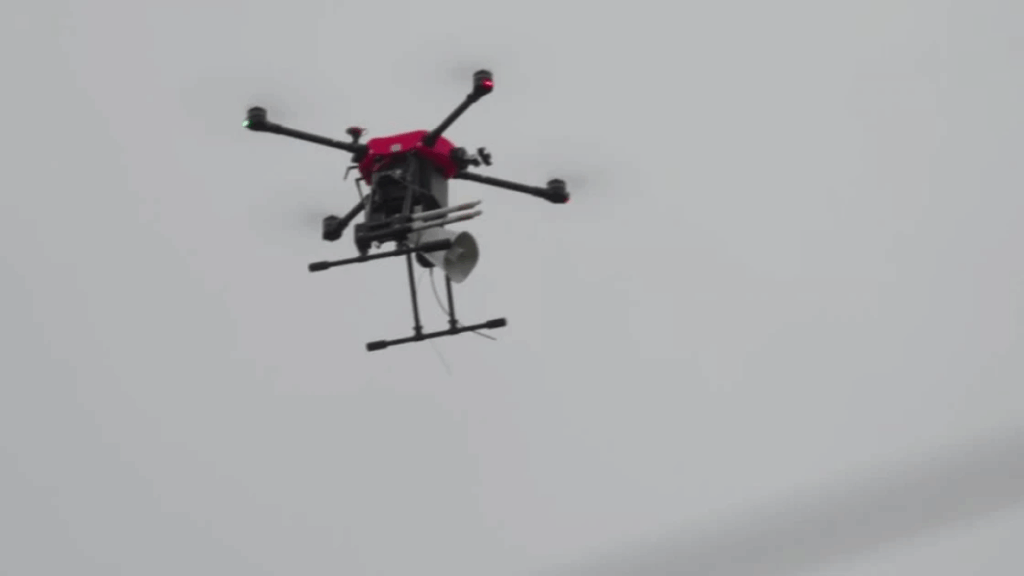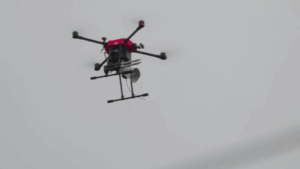Japan Deploys Barking Drones as Bear Encounters Reach Record Levels
Even schoolchildren now walk home in groups, each carrying a bell to ward off bears that tend to roam during early morning and dusk.

In Sapporo, a park adjacent to the U.S. consulate was temporarily closed after a bear was spotted wandering nearby. Photo/courtesy
By Ruth Sang
Japan has resorted to an unconventional but creative strategy against the rise in these bear incidents: neon-colored drones barking like dogs. One such device, approximately three feet across and with a pink apparatus holding cartoonish googly eyes and a large speaker underneath along with firecracker launchers mounted on both wings, kicks off from a concrete ledge in the mountains of Hida city, in central Japan’s Gifu Prefecture, on a brisk autumn day. It instantly begins emitting loud dog barks as it soars over an orchard recently experiencing a surge in bear incidents.
Known officially as the “Hunting Drone,” the device was developed by Aero Japan and is currently being tested as a deterrent at the Fruits Park Kurouchi Orchard, where the bears have been raiding apples and peaches. During one flight, it even releases two explosive firecrackers, their booms echoing across the valley in an attempt to scare off any bears concealing themselves nearby.
According to Naofumi Yoshikawa from Gifu’s environmental affairs department, the drone was introduced as a rapid countermeasure after bear sightings in Hida spiked nearly eight times compared to the previous year. Masahiko Amaki, who heads the local orchard cooperative, admitted that workers are constantly on edge due to the unpredictable bear presence. Signs at nearby hiking trails now warn visitors never to trek alone.
Japan is experiencing one of the worst periods of bear encounters it has seen in decades. According to the country’s public broadcaster, NHK, 220 people have been injured in bear attacks since April, and thirteen have lost their lives-seven of them in the past month as bears aggressively forage before going into hibernation. Most of those incidents happened in remote rural areas that are rarely visited by foreigners; however, a recent attack on a Spanish tourist in Shirakawa-go, a UNESCO-listed village known for its traditional thatched houses, has increased concerns among local authorities.
Shirakawa-go has planted warning signs up and down its scenic streets. Plenty of tourists pose next to the signs, mimicking growling bears, but many others, such as 25-year-old Cornelia Li of Shanghai, take the threat seriously. Li said she and her family followed social media reports of increased bear activity before traveling and equipped themselves with bear bells. She even attached one to her young daughter’s backpack and chose to stay in cities instead of rural towns due to safety concerns.
The United States, China, and Britain are among the countries issuing travel advisories against bear attacks in Japan. In Sapporo, a park adjacent to the U.S. consulate was temporarily closed after a bear was spotted wandering nearby.
Shirakawa Village official Shiroki Mitsunari said the tourist who was attacked suffered only minor injuries, but the incident prompted quick action. Local authorities have set honey-baited traps, cut down persimmon trees that attract bears, and instructed visitors to stick together, carry bells, and avoid poorly lit areas at night. Even schoolchildren now walk home in groups, each carrying a bell to ward off bears that tend to roam during early morning and dusk.
Mitsunari, who grew up in the mountain village, said the attack felt like a failure on their part and vowed never to let the same incident happen. While considered globally vulnerable, the number of Asiatic black bears in Japan has tripled since 2012, thanks partly to reduced hunting. According to experts, global warming has interfered with natural supplies of food like acorns and beechnuts, sending them into human settlements. The situation has grown so grave in northern parts of Japan that the government recently brought in the military to help contain the bear population.








